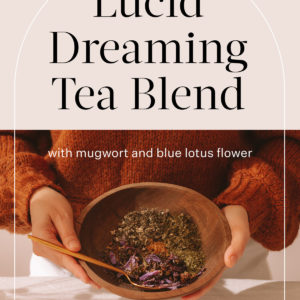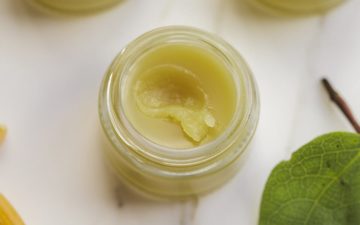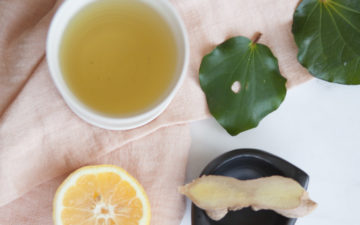If you’re seeking prophetic and magical dreamscapes, read on, I’ll show you how to make mugwort tea for lucid dreams in higher realms!

☁️ They say that if you can remember a dream, it wasn’t but a dream – it was a message. And if there were one herb to help aid the development of prophetic dreams – it would be mugwort, Artemisia vulgaris.
Have your dream journal at the ready, I’ll show you how to make mugwort tea, and wax lyrical on the spiritual and magical properties of this wonderful plant.
Jump to:
🌿An intro to mugwort
Mugwort is a member of the asteraceae family native to Europe and Asia. It is a rather tall plant with robust roots, a silvery underside to its leaves (a lunar herb signature) and can become quite an invasive species. Many consider it a weed!
Mugwort has a long history of use in herbal medicine and is equally as revered for its spiritual properties. It was referred to as “mater herbarum” (the mother of herbs) in the Middle Ages.
This was a plant called on for ritual and ceremony, used to make incense and smoke bundles to purify the sick and keep bad spirits at bay.
Mugwort’s botanical namesake is the Greek Goddess Artemis, goddess of nature, the moon and women of childbearing age – giving a hint as to its traditional uses in supporting menstrual cycles.
Although there are hundreds of species of Artemisia, it is the common mugwort we’re focusing on today.
🍵What is mugwort tea?
Mugwort tea is a herbal infusion prepared from the fresh or dried leaves and flowering tops of the Artemisia vulgaris plant. Aside from being taken for its therapeutic effects, mugwort is a highly renowned dreaming herb.

🍃What does mugwort tea taste like?
Mugwort tea tastes slightly bitter with some pungency due to the presence of essential oils. This means the bitterness provides cooling, drying effects to the tissues while the aromatics are warm and dispersive.
🧘🏿♀️Benefits
Mugwort is regarded as a digestive aid first and foremost.
Thanks to its bitter principles (the sesquiterpene lactones), it promotes secretions throughout the gastrointestinal tract (stomach, pancreas, liver and gallbladder), aiding in constipation and assimilation of nutrients.
With the added influence of the volatile oil content, mugwort is ideal to support a healthy appetite whilst addressing common digestive complaints such as indigestion, bloating, belching and gas [1].
You may spot mugwort in a formula for digestive bitters – perhaps alongside herbs such as elecampane, dandelion and gentian.
Mugwort supports female reproductive health by acting as an efficient emmenagogue (a herb that stimulates menstrual flow), bringing on a delayed period whilst increasing blood circulation to the pelvis to bring warmth, reduce stagnation, relieve menstrual cramps and ease pain.
Mugwort has a relaxant and mildly sedating effect on the nervous system, and is suited to those who may be highly tense, stressed and anxious with difficulty getting to sleep.
Mugwort leaves also have diuretic, antiseptic, antiparasitic and antifungal properties.
In Traditional Chinese Medicine, mugwort is used in a healing therapy called moxibustion, whereby the dried herb is burnt in close proximity to the skin to amplify the effects of acupuncture and promote the flow of chi [2].
There is a much more detailed monograph on mugwort and its medicinal benefits here.

✋🏽Cautions
- Mugwort should not be used in high doses or frequent use. This is due to the thujone content, a volatile oil that can be neurotoxic if taken in excess (hence a blended tea is a safer option)
- Due to its stimulating effect on the uterus, mugwort should not be used in pregnancy. Avoid if nursing
- Due to the sesquiterpene lactones, mugwort is a potential allergen in sensitive individuals, particularly if there is a known allergy to other plants in the asteraceae family (Ganora, 2009)
As always, this content is for informational purposes only. If you intend on working with mugwort therapeutically, do so safely and under the guidance of your qualified medical herbalist or other healthcare provider. Keep your doctor and pharmacist informed of your use of medicinal herbs.
👁️Mugwort spiritual uses
I have to wonder if there’s a little Witch in all us herbalists – I just can’t help but find the mystical and spiritual aspects of a plant so thrilling, and I know I’m not alone.
Being a lunar herb, mugwort is considered a bridge to other realms. According to lore, the herb was used to enhance psychic abilities such as clairvoyance and clairaudience, while helping you cross the threshold from the visible to the unseen – inducing lucid, prophetic dreams, while aiding in astral travel.
Mugwort offers protection while conducting spiritual work, and is used to purify spiritual tools.
Through the channeling of Gurudus by Kevin Ryerson (1983), it’s told mugwort affects all subtle bodies and is associated with the 6th chakra – the third eye.
In the book, Entering Hekete’s Garden, author Cyndi Brannen, PhD, offers a unique method of activating the third eye. Her recommendation is to create a mugwort medicine patch, which is simply a poultice made from the herb, to place over the forehead to detoxify the third eye and increase psychic vision.

🧝🏻♀️Mugwort magical properties
In European folklore, mugwort was placed in Roman soldier’s shoes to promote strength and relieve fatigue throughout long journeys.
Carrying mugwort on your person was said to be protective of evil spirits, poison or attack by animals. Similarly, bundles hung in the home would offer protection, the scent warding off illness.
Mugwort can be woven into all spells and rituals, and used as an incense or smudge stick to cleanse and activate altars and sacred spaces.
In magic, is it considered one of the prime herbs for dreaming, and often features in psychic tea blends.
🌜Using mugwort for dreams
Mugwort is known as an oneirogen, a term that describes a class of herbs that enhance dream states.
Mugwort can be smoked or taken as a tea or tincture to enter into a relaxed meditative state, facilitate lucid dreaming and aid in dream recall.
As mentioned in the cautions above, this visionary herb isn’t suited to long term use, due to the thujone content and its potential for adverse effects.
Nevertheless, you can access the herb’s oneirogen effects without taking it internally by simply creating a mugwort dream pillow.
Fill a small muslin bag with the dried leaf and flower tops, then slip inside your pillow at night.

🍵How to make mugwort tea
To make mugwort tea, use 1 teaspoon (1.2 g) of the dried aerial parts, to one cup of boiling water.
For best results, brew for about five minutes with the lid on to capture the volatile oils, otherwise they will simply evaporate out.
Enjoy a cup of mugwort tea up to 3x daily, short term (up to two weeks) [2].
🍯 If you find mugwort tea to be bitter, sweeten with honey if need be, or use it in a blend as described below.
🛌🏾Mugwort lucid dreaming tea blend
Due to mugwort’s bitterness, making a lucid dreaming tea blend is a nice way to incorporate the herb without compromising on taste.
This is a formula I have created that uses herbs synergistic to mugwort.
Passionflower is a nervine relaxant, blue lotus flower is a fellow dream herb that additionally promotes relaxation and euphoria, ginkgo leaf increases circulation to the brain to aid memory and dream recall, with the orange peel purely to flavour.
It is super mild in taste, no need to even add honey.

🌿Enjoyed this recipe? Leave a comment below, better yet - share a snap with me on instagram @ascensionkitchen. If you're after personalised health and nutrition advice, contact my clinic, I'd be happy to work with you.
📖Recipe

Mugwort lucid dreaming tea recipe
Ingredients
Formula:
- 2 parts Mugwort Artemesia vulgaris
- 2 parts Blue lotus flower petals Nymphaea caerulea
- 1 part Passionflower Passiflora incarnata
- 1 part Ginkgo leaf Ginkgo biloba
- ½ part Dried orange peel
For a small jar (approx. 30g / 1oz):
- 5 g Mugwort
- 5 g Blue lotus flower petals
- 2.5 g Passionflower
- 2.5 g Ginkgo leaf
- 1.5 g Dried orange peel
Instructions
- Combine all herbs in a bowl and mix together.
- Transfer to a clean glass jar, label and date.

- Use 1 teaspoon of this blend to one cup boiling water, steeping for five minutes with a lid over the top to retain the volatile oils.
- Strain into a tea cup.
- Enjoy a cup of tea in the evening for adventures into the astral realm at night.
Notes
- Scale the tea up as needed
- Mugwort’s effects are calming, relaxing, while promoting sleep and vivid dreams.
Blue lotus flower is similar in nature (tip: try sourcing from Etsy) - Passionflower relaxes the nervous system and acts as a mild sedative
- Ginkgo increases circulation to the brain to aid in dream recall
- The orange peel is purely for flavour – feel free to add more to your liking.







Gloria Wilcox
The package of Mugwort (Artemisia Vulgaris) I purchased states on the package "Not for internal use".
Kairos (TM) is the Logo on the package and the. 5oz package is distributed by Atlanta Candles & Incense.
I have never seen this on a herb package before, especially when I know the herb can be made into a Tea.
Do you have any opinions on my packaging wording?
Lauren Glucina • Naturopath, Nutritionist
Best to contact them directly Gloria, I'm not sure why they would have labeled it that way.
Peta
I love this article, and will definitely try making the tea.
Where is a good place to learn about herbalism? I find it so fascinating - would love to learn more.
Lauren Glucina • Naturopath, Nutritionist
Hey Peta, thanks for your comment, you might like to try The Herbal Academy out, they have some fantastic courses. I am an affiliate for them 🙂